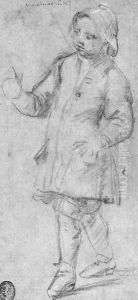Tomaso Redi Paintings
Tomaso Redi was an Italian painter of the late Baroque period, born in Florence, Italy in 1665. He was a contemporary of other Italian Baroque artists and was part of the rich tapestry of artistic expression that characterized the Italian art scene during the 17th and early 18th centuries. Redi's artistic journey was largely influenced by the cultural vibrancy of Florence, which at the time was a hub for artists, patrons, and a flourishing art market.
Redi received his artistic training in Florence, where he was a pupil of the painter Anton Domenico Gabbiani. Under Gabbiani's tutelage, Redi honed his skills in painting, particularly excelling in the creation of frescoes, which were a popular medium in the decoration of palaces and churches during the Baroque period. His works are characterized by their dynamic compositions, vibrant colors, and the dramatic use of light and shadow—a style known as chiaroscuro, which was a hallmark of Baroque art.
During his career, Redi worked on a number of significant projects, including the decoration of various buildings and churches in Florence. One of his most notable contributions was his work in the Palazzo Medici Riccardi, where he painted a series of frescoes. Redi's work in the realm of religious painting was also significant, with several of his altarpieces and religious works being displayed in Florentine churches, demonstrating his ability to convey spiritual themes with emotional depth and technical prowess.
Tomaso Redi's legacy is that of a skilled Baroque artist whose work contributed to the rich cultural heritage of Florence. His paintings, although perhaps not as widely recognized as those of some of his contemporaries, exhibit the lively and dramatic qualities that define the Baroque period. Redi passed away in 1726 in his hometown of Florence, leaving behind a body of work that continues to be studied and appreciated for its artistic merit and historical significance within the context of Italian Baroque art.
